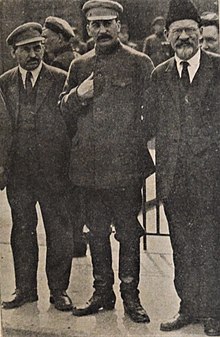Mikhail Tomsky
This article needs additional citations for verification. (May 2021) |
You can help expand this article with text translated from the corresponding article in Russian. (May 2021) Click [show] for important translation instructions.
|
Mikhail Tomsky | |
|---|---|
Михаил Томский | |
13th Orgburo | |
| In office 2 June 1924 – 1 January 1926 | |
| In office 5 April 1920 – 16 March 1921 | |
| Personal details | |
| Born | Mikhail Pavlovich Yefremov 31 October 1880 |
| Occupation | Trade unionist |
Mikhail Pavlovich Tomsky (
In his youth, Tomsky worked at the Smirnov Engineering factory in St. Petersburg, but was eventually dismissed from that job for attempting to organise a trade union.[2]
His labour activities radicalized him politically and led him to become a
During the
Early life (1880–1920)
Born in
He escaped and returned to St. Petersburg where he became president of the Union of Engravers and Chromolithographers.
Tomsky was arrested in 1908 and then exiled to
Career (1920–1928)

He was elected to the
Tomsky was an ally of
Together, they were allied with
Demise (1928–1936)
In 1928 Stalin moved against his former allies, defeating Bukharin, Rykov and Tomsky at the April 1929 Plenary Meeting of the Central Committee and forcing Tomsky to resign from his position as leader of the trade union movement in May 1929. Tomsky was put in charge of the Soviet chemical industry, a position which he occupied until 1930. He was not re-elected to the Politburo after the 16th Communist Party Congress in July 1930, but remained a full member of the Central Committee until the next Congress in January 1934, when he was demoted to candidate (non-voting) member.
Tomsky headed the State Publishing House from May 1932 until August 1936, when he was accused of terrorist connections during the
Legacy
Tomsky was posthumously found guilty of participation in an anti-Soviet conspiracy during the
In 1988, during Perestroika, the Soviet government cleared Tomsky of all charges, and he was reinstated as a member of the Communist Party of the Soviet Union.[3]
References
- ^ Wynn, Charters. From the Factory to the Kremlin: Mikhail Tomsky and the Russian Worker, University of Texas at Austin, 22 May 1996. University Center for International Research, University of Pittsburg, 10 September 2002, www.ucis.pitt.edu/nceeer/1996-809-09-Wynn.pdf. Accessed 29 May 2021. "Archive" (PDF). Archived from the original on 29 April 2019. Retrieved 30 May 2021.
{{cite web}}: CS1 maint: bot: original URL status unknown (link) - ^ a b c "Tomsky". Archived from the original on 2010-12-09. Retrieved 2011-02-20..
- ^ a b c d e "Tomsky, Mikhail Pavlovich". CHRONOS (in Russian). Vyacheslav Rumyantsev (editor of "CHRONOS"). Archived from the original on 10 August 2020. Retrieved 29 May 2021.
Bibliography
- Kaplan, Frederick (1968). Bolshevik Ideology and the Ethics of Soviet Labor. Philosophical Library.
- Politicheckie deyateli Rossii 1917: Biograficheskij slovar'. Moscow, 1993. Excerpts available online.
- Robert C. Tucker, Memoir of a Stalin Biographer
External links
- Works by or about Mikhail Tomsky at Internet Archive
- Tomsky Archive Marxists Internet Archive
- The trade unions, the party and the state a pamphlet by Tomsky
